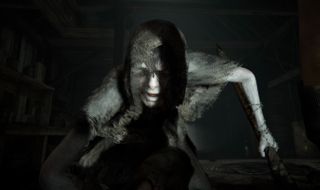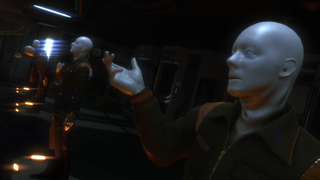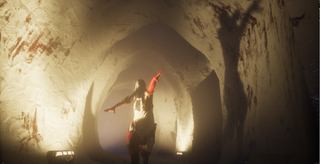What horror game creators think about jump scares
Cheap scare or great scare?

Jump scares are often considered cheap scares, and to some extent that reputation is justified. I've played games and seen films where the scares are exhausting rather than exciting, and they're not much more sophisticated than someone jumping out of a cupboard and shouting 'boo'. Context is everything, though—jump scares can be a valid device in horror if it doesn't feel like the only thing the creators are throwing at you.
"If you don’t do the suspense correctly," said James Wan, director of movies like The Conjuring and Saw, back in 2016, "then your jump scares are not going to work." The same principle applies to games.
Fear tactics
"They definitely have a place," says Dion Lay, who was one of the writers on Alien: Isolation at Creative Assembly, when I ask about jump scares. "One of the reasons I love horror is because the genre is wide enough to be so many different things—slasher, ghost story, even comedy—and there are so many tools to use. Jump scares are one of the minor tools—more like a bit of spice you add to the main course—but used correctly they can help maintain pace and tension without exhausting the player. You can even use a dummy jump scare or fake out to signal to the player that they can relax a little—'you’ve had your scare for now, we'll let you take a breather.' They're good to contrast with the prolonged terror of the main threat, or the slow burn of the dread cultivated by the location and soundtrack."
In 2014, we voted Alien: Isolation our game of the year. It's a sophisticated survival horror game where you're pursued by an unpredictable alien foe for most of the story's 20-hour lifespan. There's no shortage of what I would call jump scares, as the alien and android foes try to kill you, but they don't feel cheap because you have a lot of information about what's going on. If the alien is in the vent above, you'll see drool spilling out of it. The motion tracker gives you an idea of where enemies are at all times. And if an android's eyes are lit up, it'll probably come to life and grab you. You'll jump a lot, but the quality of the space station setting creates a consistent tension, and these peaks effectively break up a long game.

"Jump scares are an ingredient," says Red Barrels co-founder Philippe Morin, developer of both Outlast games. "Throughout the development of Outlast 2, we’ve had people telling us the game doesn’t have enough jump scares and others who felt there were too many. Horror is incredibly subjective and good jump scares aren’t easy to do well because it’s all about what leads up to the big scream. You need to stretch the tension for the right amount of time, to the point that the player almost wants the jump scare to happen because they can’t take the stress anymore." When they hit, they have to hit hard. "Good jump scares should stay with you, putting you in a state of discomfort for the whole game."
"In my opinion, the most important aspect of jump scares is the threat of them," says Thomas Grip, creative director of Frictional Games, developer of Soma and Amnesia: The Dark Descent. "They act in a similar manner to fail states—they're something that the player is afraid of, or at least anxious about. Once you get the players to realise that jump scares will be a thing, they will start to anticipate them, adding to the fear factor in different scenes. So, when a player enters a new room, they're worried that something might pop out and give them a spook, and that puts them in an anxious state—even if the scare never comes."
Unlike fail states, Grip says, jump scares offer consequences to the player without disrupting the flow of the game. "If you use them too much, however, players will get used to them and the effect will wear off. What you're looking for is using just the right amount of jump scares to keep players on their toes."
The biggest gaming news, reviews and hardware deals
Keep up to date with the most important stories and the best deals, as picked by the PC Gamer team.
Jordan Thomas, who worked on all three BioShock games and co-op horror game The Blackout Club, says that easy access to game engines has played a key role in the rise of jump scare-driven games. "I think the intersection between the rise of streamers, the rise of torture porn in other media (not so much games) and the cheapness of indie game engines has made the horror genre—which used to be rare to the point of being actively depressing—flooded with the lowest rent, C and D-movie versions of videogames where you're walking around with a badly-rendered flashlight texture and things pop out of closets at you. That is not the horror that I was hoping would be born around the 2000s."
Let's plays and reaction videos
The Let's Play and reaction videos that sprung up around games like Slender: The Eight Pages, Amnesia, Outlast and PT suggested that the way people were consuming horror games was changing.
"When we launched the very first trailer of Outlast in October 2012, we kept seeing comments about some dude named PewDiePie," says Morin. A 2013 video of PewDiePie playing Outlast, embedded above, has been viewed over 18 million times. "People were saying how they couldn’t wait for him to play the game and how he would freak out because of the name of our studio, Red Barrels. In finding out who this guy was, we discovered the YouTuber phenomenon. The timing of Outlast was good, so we decided to roll with it."
Reaction videos have become synonymous with the horror genre, which has benefits in terms of exposure, but also rumbles the all-important surprises of a horror game to a potentially massive audience. "It is a bit of a weird relationship, because you don’t want your horror game to be spoiled but then as a new studio with a new IP, you need the visibility," Morin says.
"In the end, you just hope those who intend on playing the game won’t watch the full playthroughs. You can’t know for sure if sales will be lost due to people watching full playthroughs. As far as I know, no one has this type of data. Since the first Outlast has been downloaded by 15 million people, I’m guessing there are two different groups, and those who watch YouTubers play singleplayer horror games wouldn’t consider buying them anyway."
"I think one of the first examples I watched of those was actually Alien: Isolation just after it was released," says Creative Assembly's Dion Lay when I ask if reaction videos have influenced the direction of horror games. "I was surprised how much I enjoyed watching someone else play a game. It’s like being in a cinema where everyone in it jumps, then laughs with relief, and the shared experience enhances the feeling. I can imagine developers having a ‘What is our Let’s Play moment?’ question when making a game, but I don’t think they would influence the direction beyond wanting the game to give players talking points, or making it a cinematic experience."
Frictional's Thomas Grip, however, thinks the rise of YouTube reaction videos have affected the direction of horror games "quite a bit". "When a YouTuber plays a game, it's in their best interest to put on a show that will entertain their audience. They go into a game being much more mindful of their own reactions compared to your average player. For some games, horror being a prime example, this means that their behaviour is close to the intended experience.

"For instance, I want my players to pay close attention to different sounds, to peek around corners and so forth. When playing horror games, YouTubers tend to gravitate towards this sort of behaviour, meaning they present the game in a good light. When people watch these videos, they learn how to approach the game, which they can later apply to their own playthrough." Grip believes the benefit is that audiences are more open to the idea of inhabiting their character's narrative role in a horror game. This means developers can lean more on storytelling and mood more than traditionally gamey elements like crafting systems or combat—indeed, Andy praised Frictional's Soma for its minimalism.
The state of horror
Big-budget horror had a bit of a renaissance beginning in 2017, with both Resident Evil 7 and The Evil Within 2 impressing. Each brought their own inventive angles to well-worn templates of the genre, with Resi 7's videotapes presenting Saw-style fragments of thrilling horror scenarios and The Evil Within 2 experimenting with more open environments. Besides those, the likes of Detention, Darkwood, Little Nightmares and Prey each blend horror with different genres in refreshing ways—even if I will call out Prey's mimic enemies for offering so many jump scares that it tested my tolerance a bit. You don't have to dig particularly deep to find cheap jump scare-driven games on Steam, but the most interesting voices in horror are surfacing regardless.
"I think we've come through the era of the jump scare to an extent, although there are still thousands of them being produced, and we're beginning to see horror creep into simulations and games I would actually enjoy," Thomas says. He cites survival game The Forest as an example of an open-ended scary game where players can figure out solutions themselves. "There's no right way to play that game—you're constructing any success that you have." Thomas likes the idea of jump scares generated by systems, rather than scripted events—he wants his next game to allow four players, in co-op, to create the kind of scary moments you'd only usually see in cutscenes.
"If jump scares happened in The Blackout Club, they happened out of the rules and out of your decisions, as opposed to because we ambushed you with scripting. Like [2014 movie] It Follows, which is my touchstone in a lot of ways, what I'm hoping you're feeling is that something is hunting me, and it's getting closer. And yes, maybe it's eventually going to jump out, but I'm much more interested in that curve towards the unknown. That curve towards a crisis of faith."

My interviewees all agree that jump scares have some place in even the best horror games—whether they're generated by the combination of the player and the game's systems, or used as peaks in games with long stretches of tension. They're easy to use cheaply, but if the player is captivated by the game's setting or story, they're likely to go along with them.
"I'm not a fan of horror games that just feel like a random collection of scares," says Grip when I ask what makes a great scary game. "Instead I want a cohesive experience where you're trying to replicate a certain kind of scenario. I want the game to feel like a unfolding narrative, and not just a theme park attraction. In order to do this the player needs to know what sort of character they're playing as, and what this character is trying to achieve. This might sound pretty basic, but it's something I find lacking in many horror games."
The player's imagination is arguably the most powerful tool in making a great horror game. "The environmental clues, background lore, sounds and so forth should give the player vivid mental imagery of the horrors that await," Grip says. "The hard part is keeping the threats vague enough to keep the player's imagination running, but still clear enough for the player to feel like they are, indeed, playing a game. This is really, really hard and achieving that balance is often what makes or breaks a horror game."
Most Popular

